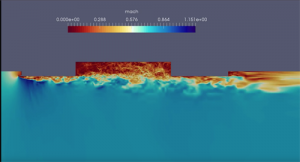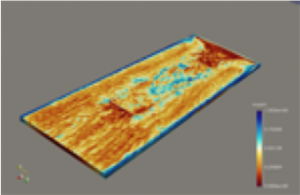Andrei Cimpoeru, CFD engineer, and David Standingford, Lead Technologist at CFMS, discuss the industrialisation of HOMs, based on recent work in the aerospace, automotive, civil and renewables sectors. These sectors have different expectations of the levels of raw accuracy in simulations and thus very different approaches to the trade off between time, cost and quality.
In industry, the drive to digitalise design and product development is seeing an increase in the use of simulation. Commonly, a digital prototype is used to predict performance of a product or process improving understanding of the conditions where it could fail allowing the design to be adapted before a physical model is constructed. Industries across sectors have to make decisions about the level of required fidelity to be used in these numerical simulations based on a trade between time, cost and quality.
As each new technology emerges, the balance between these three drivers can change – sometimes subtly, sometimes dramatically. CFMS helps industry navigate this evolving space by developing benchmarks and deploying new technologies in its independent, trusted digital test bed.
Two key technology developments have recently been disruptive in the area of Computational Fluid Dynamics (CFD) namely the development of new high-order methods (HOMs) and also the emergence of Artificial Intelligence (AI) and Machine Learning (ML).
HOMs are naturally suited to high fidelity CFD modelling. With low dispersion and dissipation, they can capture more detail in turbulent flow structures than lower-order methods. Additionally, they tend to scale very well with the current high-performance computing technologies, and show promise for when engineers will have access to even greater computational power. Recent developments on high order methods led by Dr Peter Vincent and his team at Imperial College London (ICL) have shown the art of the possible with incredible simulations using some of the world’s largest supercomputers. The routine use of such levels of fidelity within industry is still aspirational, due to the resources required. Instead, industry is looking to establish the role that HOMs will take by a process of evaluation against existing methods.
In particular, the modelling of turbulence within fluid flow is a key element of a design analysis process, where the costs can vary enormously – from standard Reynolds-averaged Navier-Stokes equations (RANS equations) simulations where turbulence structures are represented in a averaged sense, up to scale-resolving Large Eddy Simulation (LES) where individual turbulent structures are modelled and can be visualised. The hybrid Detached Eddy Simulation (DES) allows for a reduction in the associated cost by concentrating the effort on turbulence structures only in areas away from walls or boundaries.
Many of the existing processes within industry have been formed – and the best practices established – based on the turbulence models developed by academia in the 1990’s. These models were developed primarily in support of specific sectors (notably nuclear engineering) and their application in newer sectors (such as renewables) is less well established. Many of the model parameters used as defaults in the original works are less applicable in other sectors. CFD simulations designed to capture unsteady flow problems, and for resolving shed vortices and wakes, struggle with standard CFD methods, and this is where the new HOMs can really make a difference.
Figures: Numerical solution on the ARA Transonic Cavity Model using fourth order (P3 polynomial) high order methods (HOMs) using DES. The left hand side image shows the flow at the top of the cavity while the right figure highlights the turbulent field in the symmetry plane at Mach = 0.86 and Reynolds number = 1.8 x 106. This type of simulation was, until recently, regarded as unaffordable to all but the top research institutions in the world, but the emergence of new high-power GPU-based computing and many-core architectures has made it accessible for industrial research.
For CFD technology based on the standard second-order finite difference methods (including most commercially available solvers), increased resolution of structures of interest (such as vortices for vehicle design, or flow separations for aircraft) required a refinement of the mesh – the points, lines and cells that occupy the space around a body in a fluid flow. With new HOMs, the level of accuracy or resolution can be increased locally (with an increased order of polynomial) without the need for re-meshing a geometry. As a process improvement, HOMs offer a much quicker way to focus on areas of engineering interest.
Cloud computing platforms are already offering a glimpse at this as they enable engineers to run simulations on tens of thousands of cores at once, and provide organisations with an opportunity to trial new technology before committing to process change. As an impartial expert, CFMS offers guidance on how to leverage this hardware, and understand and better model a flow using high-order numerical methods.
CFMS is exploring the modelling technologies and approaches to the fidelity of turbulence modelling. To find out more and to get involved, contact us or email info@cfms.org.uk

